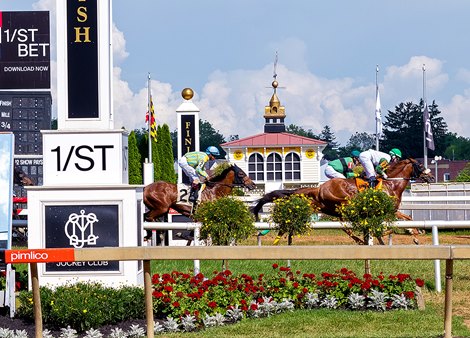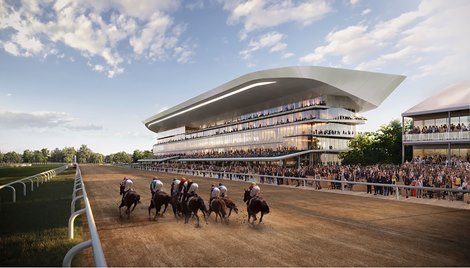As racing moves forward on new facilities at Belmont Park and Pimlico Race Course, decision makers involved in those projects are focused on what today’s fans desire in sports and entertainment facilities as they view the projects as a critical to bringing new fans to the sport.
Participating in a panel at the Racing and Gaming Conference at Saratoga Aug. 13, New York Racing Association CEO and president David O’Rourke and Maryland Thoroughbred Horsemen’s Association general counsel Alan Foreman said that approach will deliver facilities that attract and introduce fans to racing.
O’Rourke outlined plans for a new Belmont Park and Foreman talked about a new Pimlico Race Course. Belmont Park is the home of the Belmont Stakes (G1) and Pimlico hosts the Preakness Stakes (G1).
O’Rourke said grandstands built for 30,000 people to come out and bet on racing are not in step with what today’s younger people want out of their sports and entertainment facilities. He noted that as betting has largely moved to mobile and online wagering, track facilities have moved to the forefront of bringing people to racing.
Part of bringing the homes of two-thirds of the Triple Crown up to the expectations of today’s fans will be the addition of luxury suites and special seating to match what other major sporting venues make available to patrons.
An artist’s rendering of the new Belmont Park
O’Rourke said the former 1.3 million square foot grandstand at Belmont has been razed and will be replaced by a grandstand in the 275,000-300,000 square feet range.
“It was 1.3 million square feet and there were zero suites,” O’Rourke said. “That had to be some sort of record. The new one will have those amenities.”
That seating will benefit NYRA’s bottom line and fan satisfaction for events such as the Belmont Stakes Racing Festival and a return of the Breeders’ Cup to New York. Beyond that though, O’Rourke is excited about the 30 acres of access for fans throughout the property that has added tunnels to the infield. He sees these areas as a great opportunity to make Belmont a great fit for the community, along with the new UBS Arena at Belmont and the mall being developed across the street.
O’Rourke said the backyard at Saratoga Race Course will influence many of the ideas at the new Belmont.
“In my experience in observing the sport the last 15 or 16 years, the backyard is a major incubator of fans. You see the same thing at Keeneland,” O’Rourke said. “It’s an experience that is approachable from a price point, it’s a health experience because of the interaction with the animals.
“We walk the horses through the backyard at Saratoga before each race. You’ll see kids lined up on that fence line and then they bring the horses to the paddock and you see the same thing—kids and people lined up on the fence observing these horses. Then you can go out to the rail and see the horses race—the apron is open.”
O’Rourke believes the state-of-the-art grandstand and traditional park-like areas will both be essential to the success of Belmont.
“This is more about an integrated sports and entertainment facility with a specific purpose, whether it’s for a large-scale event like the Belmont Stakes or a nice spring day on a Thursday or Friday in which a family can enjoy the day at a price point that other sports actually can’t compete with,” O’Rourke said, noting that minor league baseball has had success in generating fans with that approach.

Racing at Pimlico Race Course
After so many false starts in Maryland in the past decade-plus, Foreman emphasized that the current plan to move the state’s racing to a rebuilt Pimlico over the next few years is happening.
“There still are some skeptics running amok; until they see the wrecking ball hit the Pimlico grandstand June 1 next year, I guess they still won’t believe it,” Foreman said. “But it is going to happen.”
Foreman said he’ll probably get only one crack at a project of this scale that he said needs to be in line with an industry that has some new thinking about the way it does business.
“It’s a very unique opportunity to kind of reimagine the sport and start over again. In addition to all of the other problems racing has, our facilities are not competitive in today’s marketplace,” Foreman said, before noting facility success stories in Maryland such as the home of the Baltimore Orioles, Camden Yards. “This is a city and a state known for incorporating new facilities to a new generation of fans and incorporating it into the community. We have a rare opportunity in Maryland.”
Foreman envisions a versatile facility that will meet the expectations of today’s fans.
“They want to have an entertainment experience,” Foreman said. “They don’t want to just stay in their seat all day. They want to be able to move around. It’s going to be a smaller facility that will be accented by overlays that will surround the property that you see at professional golf tournaments and other events. It will be a beautiful piece of property that will also be commercially developed, but most importantly will facilitate racing.”
As part of the Maryland plan will include the closing of Laurel Park, Foreman outlined a plan where half the horses in training will be housed at Pimlico and half at a training center that is being determined. As Maryland wishes to have the 150th Preakness at Pimlico next year, the about two-year project will begin just after the 2025 Preakness.
“We’re going to get an opportunity when we get this—it’s called the Pimlico Plus Plan—done. It’s going to attract people to the racetrack. It’s going to be an experience,” Foreman said. “It’s going to be a unique, modern building and we’re going to present racing in a very positive way.”











